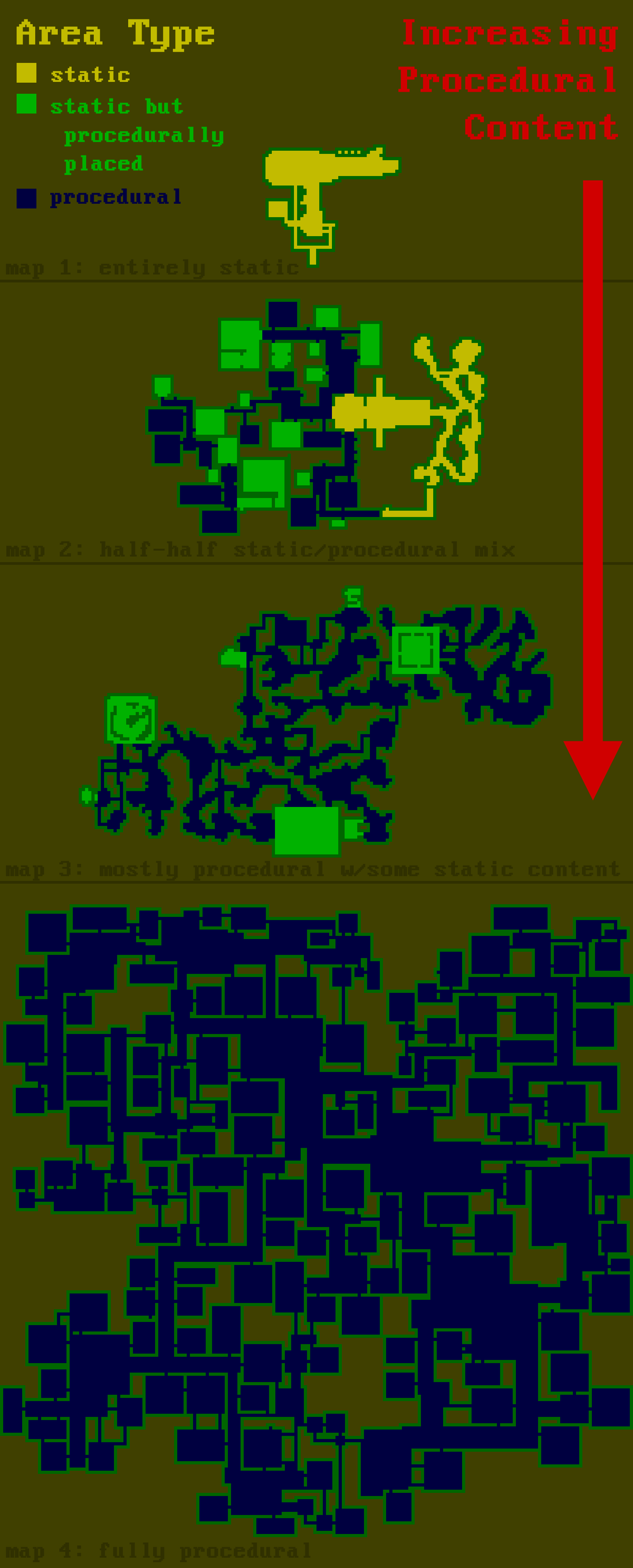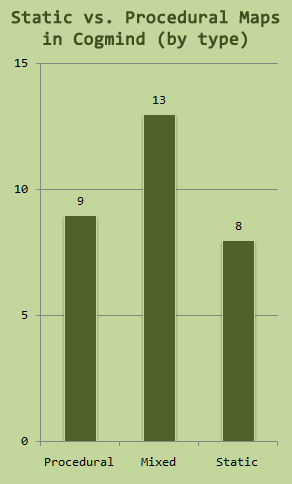Having walked through both static and procedural map design in the previous posts, this is a good opportunity to examine the qualities and value of each. Why use one over the other? Why not use both?
Roguelikes tend to be associated with procedurally generated maps, so much so that we see mainstream non-roguelike games having the “roguelike” label applied purely for that reason alone (despite possessing no other roguelike qualities…). That said, not all maps in a true roguelike need to be procedural, either, nor is that extreme necessarily desirable. Static maps can serve roguelikes well, and most sufficiently large roguelikes contain a mixture of the two.
Not every roguelike needs both static and procedural maps, but I’d argue that both are good for roguelikes, and properly mixing the two can combine their strengths into a better experience.
With procgen we get the first advantage that generally comes to mind: increased replayability. More specifically, the player lacks perfect knowledge on which to base strategic and tactical decisions, leading to variable challenges. Roguelike players also enjoy discovering interesting and unexpected results, the likelihood of which increases with the number of systems interacting with one another.
Static maps offer a much wider variety of advantages:
- They help with world building and anchor the story/lore (a topic I covered in my series on Weaving Narratives into Procedural Worlds), while also allowing for specific hand-crafted challenges.
- Being familiar with certain areas of the world means players can plan for them. Certainly a more general form of planning can be done for procgen maps through knowledge of the range of possibilities, but sometimes having more concrete goals at various points makes for interesting experiences--knowing those goals or checkpoints in advance also builds anticipation!
- In general, static maps offer a change of pace, and like good books, movies, and other forms of entertainment, varying the pace makes the content more engaging when properly spaced out. Navigating back and forth between areas of the known and unknown is also less stressful, allowing certain parts of the mind to rest for a bit.
- Outside the single-player experience, static content also has value for the community at large, giving players more concrete landmarks to discuss. They can also more easily share some of the memorable experiences related to static content that others are familiar with.
That’s a decent list!
An important point to make here is that the distinction is not absolute, either. Even individual maps do not have to belong solely to one category or the other, it’s more of a spectrum. Close to one end we have static maps with bits of procedural content, and near the other we have procedural maps including pieces of static content, either fully static by location as well, or perhaps simply “guaranteed to be on that map” but not necessarily found in the same location each time.

Demo of the static-procedural composition spectrum using several Cogmind maps as examples, from fully static to fully procedural. Larger areas are more suited to procgen :)
I went through Cogmind’s map types and classified each according to which it most closely identifies as, and found a pretty even distribution, slightly favoring mixed maps.
Note the above distribution is based on map types rather than actual map count, in which case the ratio of procedural and mixed locations in the world would both be somewhat higher than shown, each at least twice the number of static maps, rather than as close as they are now.
In any case, Cogmind has benefited greatly from having a wide variety of maps, and I highly recommend taking advantage of both approaches, considering which is more appropriate for the goals you have in a given area and the world as a whole.
For patrons, there were more comments and discussion of this article over on Patreon here.


